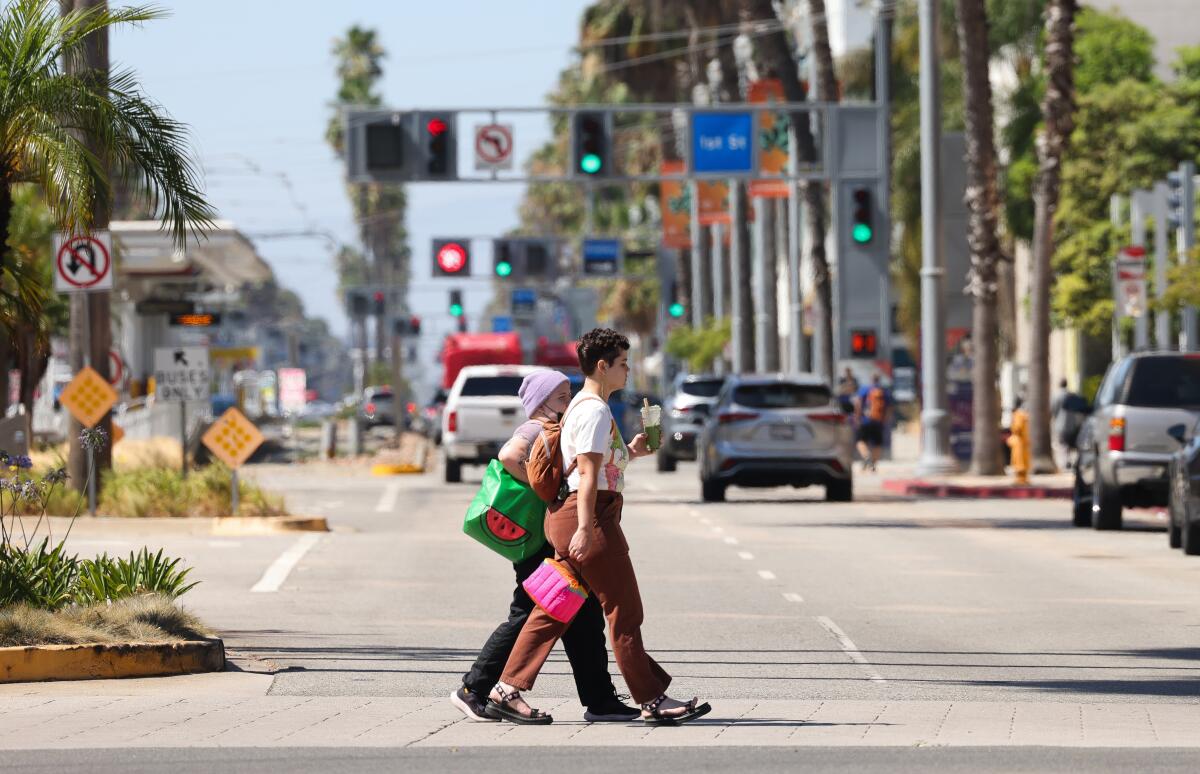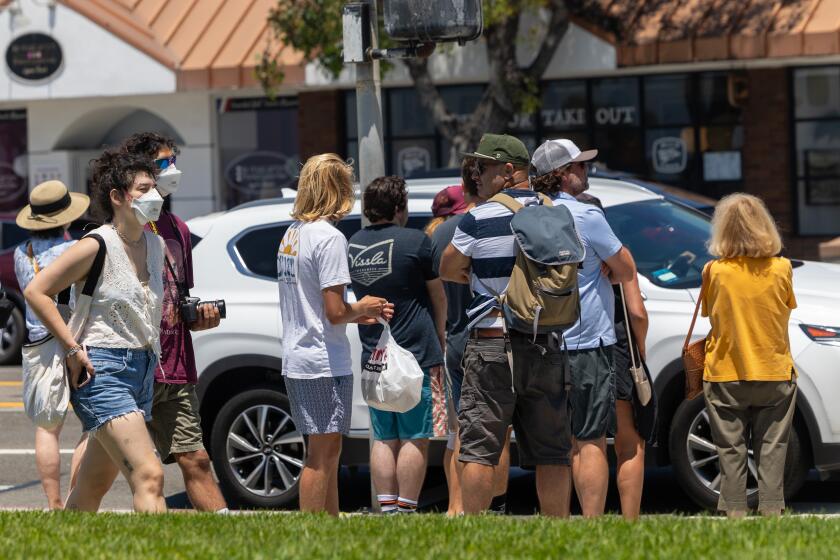‘A much more infectious’ COVID variant fueling California’s relentless surge

- Share via
California’s relentless FLiRT-fueled COVID surge is continuing to spawn infections at a dizzying rate, with coronavirus levels in wastewater reaching some of the highest levels seen since 2022.
Wastewater readings are now higher than all but one COVID peak in the last two years, and have far surpassed those seen during the typical summertime seasonal spikes in the vaccine era.
“This is a very large surge that we are seeing currently. This is starting to rival, really, what we saw this past winter,” said Dr. Elizabeth Hudson, regional chief of infectious diseases at Kaiser Permanente Southern California.
For the week that ended Aug. 10, coronavirus levels in sewage were 84% of last winter’s peak in California, according to estimates posted Friday by the U.S. Centers for Disease Control and Prevention. Coronavirus levels in wastewater have already blown past the peaks for the prior two summers, as well as the winter of 2022 to 23.
“It’s so surprising to me that it hasn’t gone down yet,” said Dr. Peter Chin-Hong, an infectious diseases specialist at UC San Francisco. “It’s a little bit more of a prolonged season for California.”
California’s strongest summer COVID wave in two years is still surging, fueled in part by the rise of a particularly hyperinfectious FLiRT subvariant known as KP.3.1.1.
There are few signs that the surge is losing steam.
The rate at which COVID-19 tests are coming back positive continues to rise. In California, 14.7% of tests done at medical facilities came back positive over the week ending Aug. 12, a rate greater than was ever seen last winter and summer. A month ago, the test positivity rate was 10.6%.
For the 10-day period that ended Aug. 3, coronavirus levels in Los Angeles County wastewater jumped to 76% of last winter’s peak, up from 54% for the 10-day period that ended July 27.
And in Santa Clara County, the most populous in the San Francisco Bay Area, coronavirus levels in wastewater were considered high in three highly populated sewersheds serving San José, Palo Alto and Sunnyvale.
The FLiRT subvariants have been the major culprits behind this summer’s COVID spike, with one in particular starting to flex its hyper-infectious muscle. KP.3.1.1 is now the single most common coronavirus strain circulating nationwide, constituting an estimated 36.8% of specimens for the two-week period that ended Saturday, up from 12.7% a month ago, CDC data show.
California’s summer COVID surge has proved to be particularly strong and enduring, as it storms to levels not seen in summertime in over two years.
“It’s this confluence of a much more infectious variant on top of folks’ overall immunity having waned — either from natural or vaccine-induced immunity,” Hudson said. “It’s just kind of come [as] a perfect storm.”
This summer’s wave is shaping up to be particularly long-lasting. California has seen “high” or “very high” levels of coronavirus in its wastewater for the last 10 weeks. In the summer of 2022, California spent 16 weeks in either of those categories, and in the summer of 2023, the state recorded eight weeks with “high” viral wastewater levels.
Cases — though assuredly an undercount, as they don’t account for people who test at home, or not at all — are nevertheless climbing. There were an average of 484 COVID-19 cases a day for the week that ended Aug. 11 in L.A. County, up 35% over the last month. Last summer’s peak was 571 cases a day.
COVID virus levels have jumped significantly in wastewater across the nation, an indication the summer bump is continuing to grow.
And COVID is sending more people to emergency rooms. For the week that ended Aug. 11, 4.3% of emergency room visits countywide were related to the coronavirus, up from 4% the prior week. Last summer’s peak was 5.1%.
Hospitalizations are ticking up, but remain a fraction of numbers from prior summers. Even in a period of rampant infection, severe illness from COVID-19 has been less common, thanks to prior immunity and widespread availability of anti-COVID medicines such as Paxlovid.
For the week that ended Aug. 10, there was a daily average of 462 coronavirus-infected people in the hospital in L.A. County, up from 407 the prior week. Last summer’s peak was 620, last winter’s was 825, and in the summer of 2022 it was more than 1,100.
At Kaiser Permanente Southern California, which covers more than 4.8 million members, the uptick in COVID has mainly resulted in increased visits to clinics and doctor’s offices.
“We’re not seeing a huge number of people who are admitted to the hospital with COVID,” Hudson said.
California is in the middle of its worst summer COVID wave since 2022, with virus levels and infections surging across the state.
COVID-19 deaths in L.A. County remain relatively stable, averaging one to two per day, although it can take time for a surge in cases to show up in fatality data.
Still, though well shy of the pandemic’s devastating early years, the overall burden of COVID remains significant. Since October, more than 49,000 COVID-19 deaths have been reported nationally, compared with at least 25,000 flu deaths that have been estimated over the same time period. An updated estimate of flu deaths is expected later this year.
“COVID-19 remains a greater cause of severe illness and death than other respiratory viruses, but the differences between these rates are much smaller than they were earlier in the pandemic,” the CDC said in March.
Those at highest risk are those who are older or immunocompromised, and have not received an updated COVID-19 vaccine within the last year.
At some point, this summer peak will crest, and the pace of new infections will begin to decrease. But it won’t be clear until a few weeks after COVID indicators begin to fall.
An open question is whether COVID will continue to rise as kids go back to school. Doctors are urging people to stay home if they’re sick and asking parents to keep their ill kids from attending school, to limit spread of disease.
The U.S. Centers for Disease Control and Prevention recommend that seniors 65 and older get a second dose of the 2023-24 COVID-19 vaccination.
Initial estimates suggest the most recent week’s worth of viral levels in California wastewater are about 3% lower than the prior week. But that figure is subject to change as more data come in.
California is one of 25 states where COVID-19 is thought to be “growing” or “likely growing,” according to the CDC. COVID-19 was seen as “likely declining” in five states — Alaska, Florida, Hawaii, Louisiana and New York. COVID-19 was either stable or uncertain in 16 states and the District of Columbia. No estimates were available for Indiana, Missouri, Wisconsin and Wyoming.
Doctors urged people, as well as healthcare providers, to get tested or order testing for their patients when dealing with respiratory illness symptoms. An initial negative test doesn’t mean you don’t have COVID; doctors suggest testing for as long as five days after the onset of symptoms to see if a test turns positive.
Dr. Abraar Karan, an infectious diseases expert and epidemiologist at Stanford University, said confirmation of a COVID-19 diagnosis would help a patient get a Paxlovid prescription to help treat the illness, while confirmation of another illness, like flu, could help a patient get a drug more targeted toward that ailment.
People with symptoms do not need to have tested positive for the coronavirus to be considered for a diagnosis of long COVID, a new report says.
More consistent testing at medical facilities could also help detection of unusual strains that epidemiologists want to track, such as bird flu. Bird flu has attracted attention recently because of outbreaks in poultry and U.S. dairy cows, and there have been several recent human cases among dairy and poultry workers in the U.S., according to the CDC.
Recent human cases of H5N1 bird flu have resulted in primarily mild symptoms, including conjunctivitis, also known as pink eye, Karan said. But a reason why doctors are closely monitoring the situation is that, in the decades in which we’ve been aware of bird flu infecting humans, some H5N1 strains have resulted in significant mortality rates. According to the CDC, human infections with H5N1 virus, which have been reported in 23 countries since 1997, have resulted in severe pneumonia and death in about 50% of cases.
Now that we know bird flu has infected cows, and there’s cow-to-human transmission, that poses a potential problem.
“Cow udders have receptors in common with birds, and they also have receptors in common with humans, where these viruses bind,” Karan said.
“Now, with human flu season coming, you have the risk of what’s called viral reassortment, where a host can get infected with both bird flu and human flu at the same time, and those flus now start swapping genetic material,” Karan said. “This is kind of how swine flu happened [in 2009]. So this is where we’re really worried. It’s like a ticking time bomb of human flu season around the corner, and yet we still have this uncontrolled spread of bird flu in cows.”
Samples of San Francisco wastewater tested positive for bird flu; authorities have yet to determine the source.
Bird flu hasn’t resulted in sustained human-to-human transmission, nor caused a pandemic in humans, in recent times.
“But it’s one of those pathogens that’s high risk of mutating to a point of increasing transmissibility. And the pathogen has had high virulence based on historical cases. ... It’s the risk of where it could go,” Karan said.
This illustrates why it can be important for patients to get tested. If a test shows that a person has the flu, subsequent screening — including genetic subtyping — could eventually determine whether a person has bird flu. And that could help epidemiologists figure out how the bird flu may have spread, and help doctors determine the best course of treatment.
Even if a case of bird flu results in mild symptoms, it’s important to diagnose it, Karan said, so the virus sample can be genetically analyzed and scientists can try to track down where it jumped from an animal to a human, and potentially more aggressively treat the patient with antivirals.
“But imagine — that only happens if I even test that patient for flu at all,” Karan said.
More to Read
Sign up for Essential California
The most important California stories and recommendations in your inbox every morning.
You may occasionally receive promotional content from the Los Angeles Times.


















